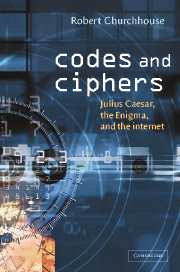Book contents
- Frontmatter
- Contents
- Preface
- 1 Introduction
- 2 From Julius Caesar to simple substitution
- 3 Polyalphabetic systems
- 4 Jigsaw ciphers
- 5 Two-letter ciphers
- 6 Codes
- 7 Ciphers for spies
- 8 Producing random numbers and letters
- 9 The Enigma cipher machine
- 10 The Hagelin cipher machine
- 11 Beyond the Enigma
- 12 Public key cryptography
- 13 Encipherment and the internet
- Appendix
- Solutions to problems
- References
- Name index
- Subject index
8 - Producing random numbers and letters
Published online by Cambridge University Press: 13 August 2009
- Frontmatter
- Contents
- Preface
- 1 Introduction
- 2 From Julius Caesar to simple substitution
- 3 Polyalphabetic systems
- 4 Jigsaw ciphers
- 5 Two-letter ciphers
- 6 Codes
- 7 Ciphers for spies
- 8 Producing random numbers and letters
- 9 The Enigma cipher machine
- 10 The Hagelin cipher machine
- 11 Beyond the Enigma
- 12 Public key cryptography
- 13 Encipherment and the internet
- Appendix
- Solutions to problems
- References
- Name index
- Subject index
Summary
Random sequences
Suppose that we have a long sequence of 0s and 1s, that is a long binary sequence. What do we mean when we say that the sequence is ‘random’? As an obvious first criterion it seems reasonable to expect that it will contain ‘about as many 0s as 1s’; but what do we mean by ‘about’?
If the sequence is exactly 1000 digits in length we would not necessarily expect it to contain exactly 500 0s and 500 1s, but if it contained, say, 700 0s and 300 1s we would surely think that it was not a random sequence. Somewhere between these two extremes would mark the limit of acceptability of what we would be prepared to accept as random: 530 0s and 470 1s for example; but another person might set different limits. Suppose, however, that the sequence did in fact consist of 500 0s followed by 500 1s. Since there are exactly 500 of each digit can we consider the sequence to be random? Clearly not, since in a random sequence we would expect the four two-digit numbers, 00, 01, 10 and 11, each to occur ‘about 250’ times but in this sequence 00 and 11 both occur 499 times, 01 occurs only once and 10 doesn't occur at all. Even if the sequence passes this test we could then ask whether the eight three-digit numbers 000, 001, 010, 011, 100, 101, 110 and 111 each occur ‘about 125’ times, and so on.
- Type
- Chapter
- Information
- Codes and CiphersJulius Caesar, the Enigma, and the Internet, pp. 94 - 109Publisher: Cambridge University PressPrint publication year: 2001



